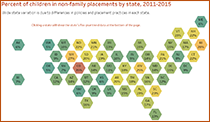State child welfare leaders and lawmakers in many states have been working to ensure that non-family placements are only used as a short-term intervention when absolutely necessary to treat the behavioral and mental health needs of youth so they can return to a family placement. Some of their work includes the following strategies:
- Absolute prohibition on placement of children under a specified age, or a prohibition on placement of children under a specified age with defined exceptions;
- Enhanced admission criteria or facility requirements for children under a specified age;
- Required justification for residential placement, for example based on the clinical needs of the child and the use of assessments to determine the level of care;
- Prior supervisory or departmental approval for residential placement;
- Case plans and placement criteria that specify purpose of placement, length of stay, and regular review;
- Mandate to close facilities or limit capacity of non-family placements;
- Explicit funding restrictions;
- Better oversight and administration of psychotropic medications for children in congregate care;
- Better state oversight and licensing of residential facilities;
- Create three-branch task forces on residential care; and
- Limitation on approval of rates for additional facilities or additional capacity.[1]
Judges and other court leaders should explore opportunities to partner with the child welfare agency and state legislature in improvement and reform efforts within their states. One opportunity is to explore the establishment of a three-branch collaboration to develop an integrated and comprehensive state approach to safe, quality, effective short-term residential interventions for children in the child welfare system.
[1] See State Policies on Non-Family Foster Care Settings, Youth Law Center (July 2015) and Congregate Care, Residential Treatment and Group Home State Legislative Enactments 2009—2013, National Conference of State Legislatures (Oct. 26, 2015).
